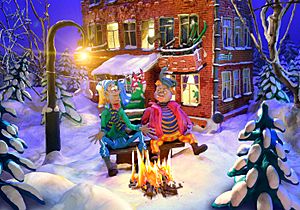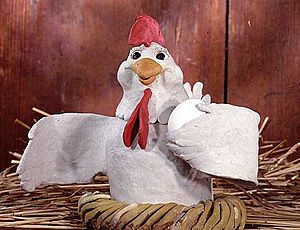Clay animation facts for kids
Clay animation or claymation, sometimes plasticine animation, is one of many forms of stop motion animation. Each animated piece, either character or background, is "deformable"—made of a malleable substance, usually plasticine clay.
Traditional animation, from cel animation to stop motion, is produced by recording each frame, or still picture, on film or digital media and then playing the recorded frames back in rapid succession before the viewer. Clay-animated films were produced in the United States as early as 1908.
Technique
Each object or character is sculpted from clay or other such similarly pliable material as plasticine, usually around a wire skeleton called an armature, and then arranged on the set, where it is photographed once before being slightly moved by hand to prepare it for the next shot, and so on until the animator has achieved the desired amount of film. Upon playback, the mind of the viewer perceives the series of slightly changing, rapidly succeeding images as motion.
Production
Producing a stop-motion animation using clay is extremely laborious. Shooting a 30-minute movie would require making approximately 21,600 stops to change the figures for the frames; a full-length (90-minute) movie, 64,800, and possibly many more.
Types
Clay animation can take several forms:
"Freeform" clay animation is an informal term referring to the process in which the shape of the clay changes radically as the animation progresses.
Another clay-animation technique, one that blurs the distinction between stop motion and traditional flat animation, is called clay painting (also a variation of the direct manipulation animation process), wherein clay is placed on a flat surface and moved like wet oil paints (as on a traditional artist's canvas) to produce any style of images, but with a clay look to them.
A sub variation clay animation can be informally called "clay melting". Any kind of heat source can be applied on or near (or below) clay to cause it to melt while an animation camera on a time-lapse setting slowly films the process.
The term "hot set" is used among animators during production. It refers to a set where an animator is filming. The clay characters are set in a perfect position where they can continue shooting where they left off. If an animator calls his set a "hot set," then no one is allowed to touch the set or else the shoot would be ruined.
Certain scenes must be shot rather quickly. If a scene is left unfinished and the weather is perhaps humid, then the set and characters have an obvious difference. The clay puppets may be deformed from the humidity or the air pressure could have caused the set to shift slightly. These small differences can create an obvious flaw to the scene. To avoid these disasters, scenes normally have to be shot in one day or less.
Examples of clay animation
Some famous clay animation movies have been made. Examples include:
Claymation
The word "Claymation" is a registered trademark in the United States. It was registered by Will Vinton in 1978 to describe his clay animation films.
Images for kids
See also
 In Spanish: Plastimación para niños
In Spanish: Plastimación para niños




